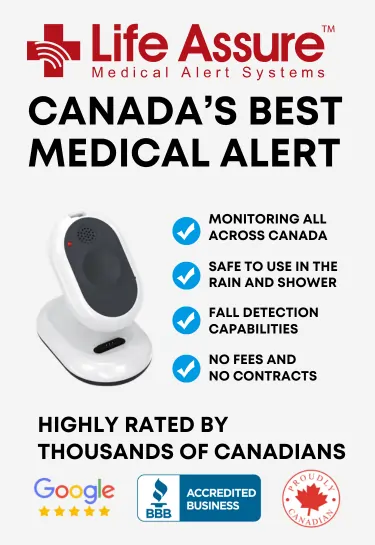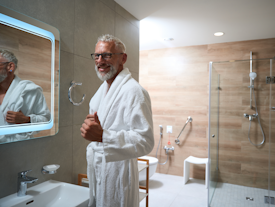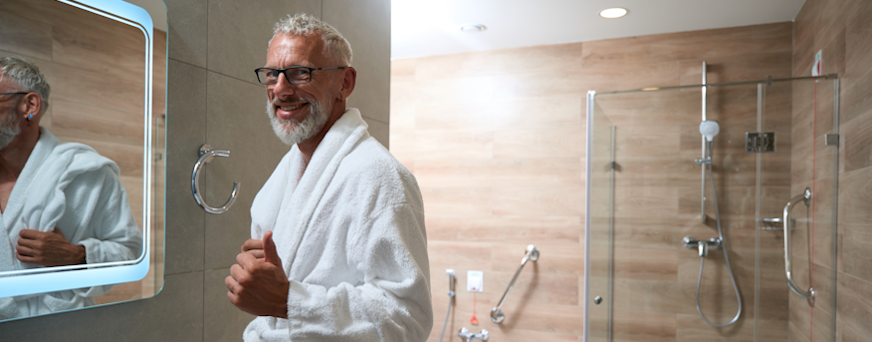How Hearing Aids For Seniors Improve Daily Living
Aging can muffle the world, but hearing aids turn it back up. They help when you miss the doorbell, TV words, or soft voices.
Seniors with age-related loss or ringing ears tend to experience an unstable life. Diabetes and heart disease often weaken hearing over time. Some medicines, like antibiotics, also harm hearing. Family history matters, too, so some older adults are more at risk.
This is where hearing aids for seniors come in handy. They sharpen speech and eliminate background noise. However, ensure to talk to a licensed audiologist for testing and the right fit for your hearing aid.
Life Assure Product Quiz
Take our 30 second quiz and discover which Life Assure medical alert device is the right fit for you or a loved ones.
Life Assure Product Quiz
Take our 30 second quiz and discover which Life Assure medical alert device is the right fit for you or a loved ones.
Why Hearing Aids Are Important For Seniors?

Hearing loss sneaks in slowly. Words blur first, and those quick little consonants slip away. Family talks feel fuzzy, and you often miss sounds. Good hearing supports memory, mood, and the rhythm of daily living.
For many Canadian seniors, hearing aids bring back connection, safety, and calm.
Hear Voices Clearly
Speech has tiny edges that carry meaning, especially the crisp “s” and “t.” Age often fades high notes, so those edges get lost in noise. Hearing aids boost those soft parts; however, they don’t blast everything louder.
A tiny chip in the aid finds speech and lifts it gently above clutter. Thus, phone calls stop feeling like puzzles, and words land where they should.
Stay Close To Family
Missed words build distance; however, clear hearing pulls families back together quickly. Grandkids talk fast; they also whisper secrets you don't want to miss.
So, with hearing aids, phone calls feel warmer because pauses and laughter sound natural again to aged adults. Thus, connection grows when hearing is steady, and trust feels safe again.
Feel Safer Each Day
Safety grows when sounds arrive on time and at true volume. Street traffic pops sooner; also, bike bells and backup beeps stand out clearly. However, loud blasts won’t sting because compression keeps peaks comfortable and clear.
Kitchen timers, smoke alarms, and microwave pings also become clear and dependable again. Better hearing in seniors steadies steps, reduces stumbles, and supports confident, everyday movement.
Reduce Listening Fatigue
Listening hard takes work, and the brain burns energy filling missing pieces. Elderly people keep guessing words all morning, then feel drained by mid-afternoon errands. Hearing aids lighten the load and also reduce that constant mental strain.
Speech becomes direct, not a puzzle, so attention can rest more often. On the other hand, less strain means better focus for medicines, meals, and plans. Energy returns for walks, hobbies, and simple joy before dinner.
How Do They Help?

Modern hearing aids are tiny sound tools. They capture sound with microphones, then shape it with fast digital math. However, the goal isn’t just “louder,” it’s making useful sounds stand out.
So, here’s how these tiny tools help seniors improve their daily living.
Boost Soft Everyday Sounds
Hearing aids listen fast and lift soft parts of speech and life. Whispers, faucets, paper pages, and quiet door clicks, you can hear them all clearly through these aids. A built-in amplifier adds gain mostly where hearing needs help most. However, loud bangs are limited, so comfort stays even across rooms.
Compression spreads volume gently, protecting ears while keeping speech details intact. In addition, many aids track environments and adjust gain without constant fiddling.
Reduce Background Noise
Noise reduction in hearing aids finds steady hums, then lowers them under the voice range. It cuts fans, engines, and cafeteria din without flattening natural speech tones. However, it keeps sending sudden alerts to aged adults, like a beeping cart or monitor nearby.
Directional mics pair with noise tools to pull voices forward. In addition, app presets make restaurant or street modes simple to choose. Fewer echoes mean less mental work and smoother talk overall.
Make TV And Calls Clear
Bluetooth streams sound straight to both ears of seniors, like tiny wireless headphones. TV dialogue gets clean because room noise does not mix in anymore. And the family still hears normal volume, which keeps the peace at home.
Call clarity improves, along with reduced hiss lines. Also, captions pair well, giving double help when words fly too fast.
Hear Alarms And Doorbells
Smart alerts send tones or gentle vibrations straight through the hearing aids for the elderly. Doorbells, timers, and delivery knocks become clear from room to room. However, you can set louder home profiles if hearing is poorer.
In addition, linked phones can flash or vibrate when alarms go off. That backup layer helps during naps, showers, or cooking. You answer faster, burn less toast, and greet visitors without missing a beat.
Chat Better In Crowds
Crowds blur words because many voices overlap and bounce off the walls. Directional microphones in the hearing aids of aged adults focus on the speaker, reducing side chatter for you. However, the aids can widen focus when someone speaks to the side.
Also, some models tag voices and keep them steady in noise. It means less interference of sounds, so you can hear every sentence clearly.
Notice Where Sounds Come From
Two ears work together, and hearing aids support that natural teamwork well. Binaural processing compares tiny timing clues to map left and right.
It steadies balance in seniors because vision and hearing cooperate closely. Hence, it helps in traffic, crosswalks, and busy stores with rolling carts. You turn the right way, not guessing wildly at every sound, and walk with easy confidence.
Custom Fit And Simple Controls Support Daily Use
Ears vary widely. So, fit matters as much as features, because leaks cause whistles and muddy bass. An audiologist shapes ear tips or molds, then fine-tunes your personal settings. However, many clinics also guide seniors on cleaning of the aids, battery care, and quick troubleshooting.
Buttons stay big and simple, while apps show clear sliders and options. In addition, rechargeable cases simplify life with overnight docks and all-day power. Regular cleanings and new wax guards keep the sound crisp. Thus, when devices fit well and stay easy, daily use becomes second nature.
Conclusion
Good hearing is not just sound; it’s freedom, safety, and warm company. Hearing aids for seniors in Canada keep that freedom every day.
They lift the soft speech of the elderly, cool the noise, and provide comfort through surprises. Thus, they do more than tune audio; they ease strain and bring back joy.




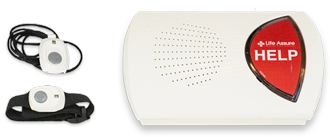


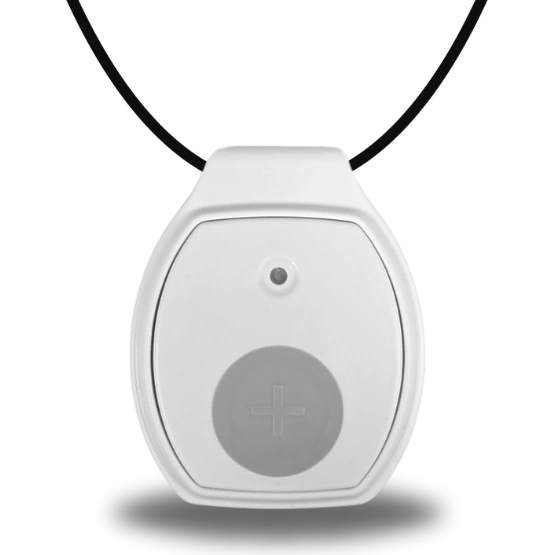
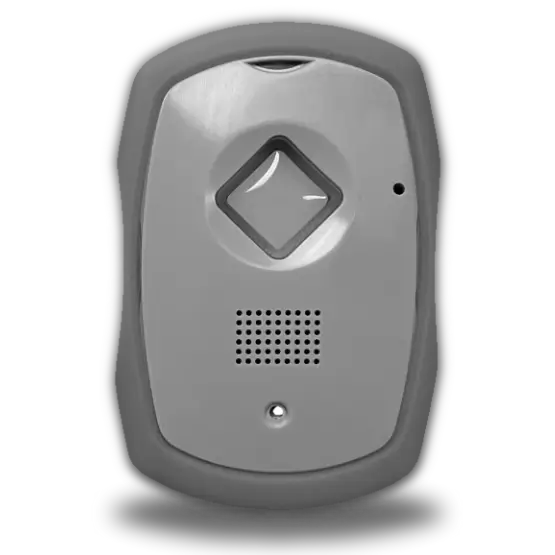


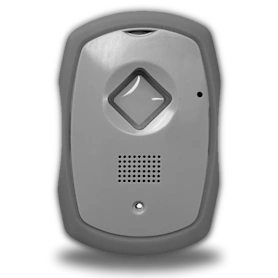
 Get Help With The Push Of
A Button
Get Help With The Push Of
A Button
